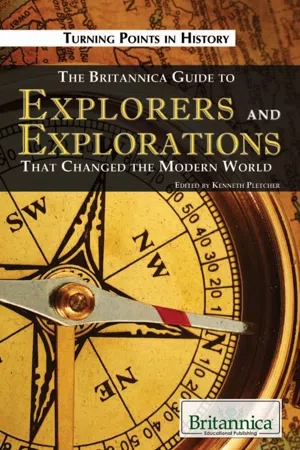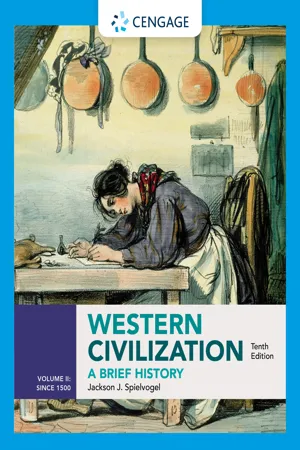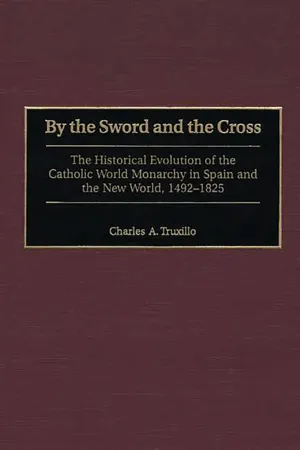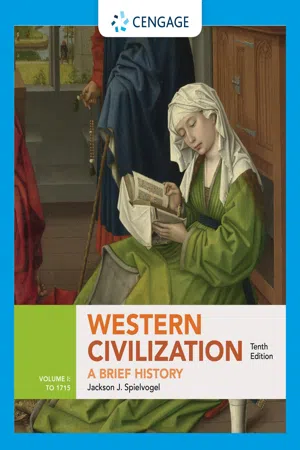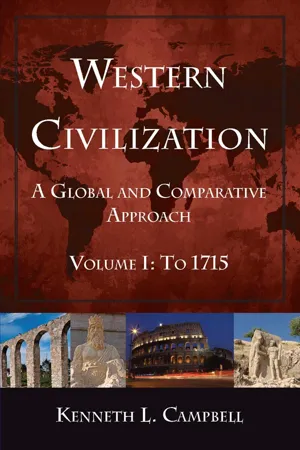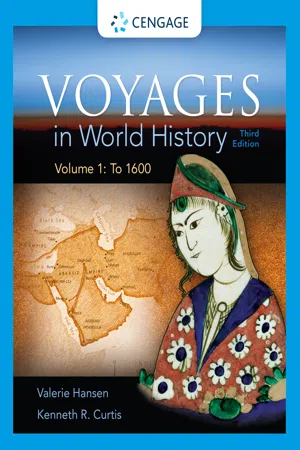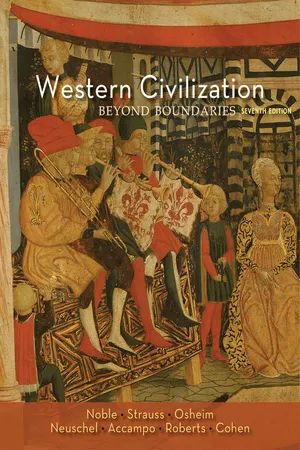History
Spanish Exploration
Spanish exploration refers to the period of exploration and colonization by Spain in the 15th to 17th centuries. Spanish explorers such as Christopher Columbus, Hernán Cortés, and Francisco Pizarro played significant roles in discovering and conquering new territories in the Americas. This exploration led to the establishment of Spanish colonies and the spread of Spanish culture, language, and influence in the New World.
Written by Perlego with AI-assistance
Related key terms
1 of 5
10 Key excerpts on "Spanish Exploration"
- eBook - PDF
Contested Eden
California Before the Gold Rush
- Ramón A. Gutiérrez, Richard J. Orsi(Authors)
- 1998(Publication Date)
- University of California Press(Publisher)
There is ample documentation concerning these later voyages of explorers such as Juan Perez, Alejandro Malaspina, and Juan Francisco de la Bodega y Quadra, which were motivated less by dreams of wealth and discovery than by considerations of defen-sive expansion, reconnaissance, and scientific investigation. The Spaniards involved dealt with Indians mostly on the simple terms of acquaintance, gift exchange, and acquisition of knowledge. The journals kept by expedition members were carefully written, straightforward accounts of first-hand observations that mainly described 4 78 One ofthe earliest maps to depict California, I lenry Briggs's The North Part of America was published in London in 1625. California, proclaims the legend in the lower left, sometymes supposed to he a part of ye westerne continent, hut scince by a Spanish Charte taken by ye I lollanders it is found to he a goodly ilande. Described as an island in a Spanish romance of 1510, Las sergas tic l$plandian, more than twenty years before Europeans first sighted the desolate lower peninsula, the two Californias—Baja and Alta—were not generally believed to be part of the mainland until the discoveries of Father Kusebio Kino in the late seventeenth and early eighteenth centuries settled the matter. From Hakluytns Posthumus or Purcbas I /is Pilgritnes (London, 1625). Courtesy Bancroft Library. rather than speculated about Indian life, customs, or religion. The expeditions de-voted to scientific inquiry paid particular attention to geographic features, fauna and flora, native vocabularies, and items of trade as representative of natural products rather than as things to be coveted. The fur trade, particularly interesting to the En-glish, Americans, and Russians, commanded less attention among Spaniards. Al-though many new works have been published both in English and Spanish on the eighteenth-century voyages, abundant documentation awaits an editor or translator. - Britannica Educational Publishing, Kenneth Pletcher(Authors)
- 2009(Publication Date)
- Britannica Educational Publishing(Publisher)
C hapter 3:Colonial Exploration of the New WorldT he age of modern colonialism began about 1500, following the European discoveries of a sea route around Africa’s southern coast (1488) and of America (1492). With these events sea power shifted from the Mediterranean to the Atlantic and to the countries that developed their maritime power. By discovery, conquest, and settlement, these nations expanded and colonized throughout the world, spreading European institutions and culture.SPAIN: THE CONQUESTS
Only gradually did the Spaniards realize the possibilities of America. They had completed the occupation of the larger West Indian islands by 1512, though they largely ignored the smaller ones, to their ultimate regret. Thus far they had found lands nearly empty of treasure, populated by inhabitants who died off rapidly on contact with Europeans. In 1508 an expedition did leave Hispaniola to colonize the mainland, and, after hardship and decimation, the remnant settled at Darién on the Isthmus of Panama, from which in 1513 Vasco Núñez de Balboa made his famous march to the Pacific. On the Isthmus the Spaniards heard garbled reports of the wealth and splendour of Inca Peru. Balboa was succeeded (and judicially murdered) by Pedrarias Dávila, who turned his attention to Central America and founded Nicaragua.Expeditions sent by Diego Velázquez, governor of Cuba, made contact with the decayed Mayan civilization of Yucatán and brought news of the cities and precious metals of Aztec Mexico. Hernán Cortés entered Mexico from Cuba in 1519 and spent two years overthrowing the Aztec confederation, which dominated Mexico’s civilized heartland. The Spaniards used firearms effectively but did most of their fighting with pikes and blades, aided by numerous Indian allies who hated the dominant Aztecs. The conquest of Aztec Mexico led directly to that of Guatemala and about half of Yucatán, whose geography and warlike inhabitants slowed Spanish progress.- eBook - PDF
General History of the Caribbean UNESCO Vol 2
New Societies: The Caribbean in the Long Sixteenth Century
- NA NA(Author)
- 2019(Publication Date)
- Palgrave Macmillan(Publisher)
4 SPANISH EXPANSION IN AMERICA, 1492 TO C. 1580 Horst Pietschmann Introduction The historical assessment of the Spanish - and to a lesser extent Portuguese - colonization of America has undergone a radical change in the present century. Until the Second World War, or thereabouts, it was regarded, in a self-assured Europe and in the countries of the American continent which were themselves heavily oriented towards Europe, as a largely positive process conducted by farsighted and bold seafarers and conquistadores. The fact that brutalities had been committed against the indigenous population was conceded with varying degrees of ambiguity; but it was still felt that the process had ultimately brought about Europeanization of the continent. Only the comparatively small group of ethnologists who specialized in America called persistent attention to the destruction of flourishing native cultures and lamented the resulting loss to the cultural heritage of mankind. Under the influence of the decolonization movement of the post-war years, worldwide emphasis on human rights and the reflection now being fostered by many countries of Latin America on their pre-Hispanic Indian past in the wake of a new nationalism, together with the waning fascination of the European model, a rapid reappraisal of the process of Iberian expansion in America set in. The emphasis was now placed on the cruelties perpetrated by the con- querors, the incredible suffering of the ancient inhabitants of the continent with the loss of population numbers and of their cultural identity, followed by repression and exploitation by the new colonial masters. This trend was favoured by a move in historical science away from the great historical prob- lems and the acts of prominent figures to research into structural relation- ships and developments. - eBook - PDF
Western Civilization
A Brief History, Volume II since 1500
- Jackson Spielvogel(Author)
- 2019(Publication Date)
- Cengage Learning EMEA(Publisher)
14-2b Voyages to the New World While the Portuguese were seeking access to the spice trade of the Indies by sailing eastward through the Indian Ocean, the Spanish were attempting to reach the same destination by sailing westward across the Atlantic. Although the Spanish came to overseas discovery and exploration after the initial efforts of the Portuguese, their greater resources enabled them to establish a far grander and quite different overseas empire. An important figure in the history of Spanish explo- ration was an Italian known as Christopher Columbus (1451-1506). Knowledgeable Europeans were aware that the world was round but had little understanding of its circumference or the extent of the continent of Asia. Convinced that the circumference of the earth was less than contemporaries believed and that Asia was larger than people thought, Columbus believed that Asia could be reached by sailing directly west instead of around Africa. After being rejected by the Portuguese, he persuaded Queen Isabella of Spain to finance his exploratory expedition. With three ships, the Santa María, the Nina, and the Pinta, and a crew of ninety men, Columbus set sail on August 3, 1492. On October 12, he reached the Bahamas and then went on to explore the coastline of Cuba and the northern shores of Hispaniola (present-day Haiti and the Dominican Republic). Columbus believed that he had reached Asia, and in his reports to Queen Isabella and King Ferdinand upon his return to Spain, he assured them not only that he would eventually find gold but also that they had a golden opportunity to convert the indigenous peoples—whom Columbus persisted in call- ing “Indians”—to Christianity. In three subsequent voy- ages (1493, 1498, and 1502), Columbus sought in vain to find a route to the Asian mainland. In his four voy- ages, Columbus landed on all the major islands of the Caribbean and the mainland of Central America, still convinced that he had reached the Indies in Asia. - Available until 31 Dec |Learn more
A Most Splendid Company
The Coronado Expedition in Global Perspective
- Richard Flint, Shirley Cushing Flint(Authors)
- 2019(Publication Date)
- University of New Mexico Press(Publisher)
Concentrating successively on each of four chrono-logical periods reveals important conclusions about why the expedition to Tierra Nueva came to be as it did and how the expedition evolved, as enthusiasm for the enterprise surged and then waned. No generation of people creates itself, but instead repre-sents a combination of outcomes deriving from and reactions to its predecessors. As we recount below (in the sections “Social Framework in Spain” and “Social Framework in Nueva España”), recovery from the prolonged catastrophe of the plague in Europe during the 1400s ushered in an extended period of population growth, economic boom, and unbridled optimism that launched Europeans on a worldwide hunt for luxuries, supported by the conviction that their quests were in all ways righteous. The first six decades of the 1500s, which comprehended the lifespans of most European members of the expedition to Tierra Nueva, were a volatile time in Europe and much of the rest of the world as it was impacted by European expansion. Thus, many attitudes and beliefs that were powerful and wide-spread at the turn of the sixteenth century had been aban-doned or radically transformed by the 1560s. During that relatively short span, Spain became a domi-nant world power and then entered a steep decline. The Roman Catholic Church at first held “universal” sway in Europe, but then was repeatedly challenged by Protestant reforms, and subsequently launched a militant counterattack against the reformers and their followers. The dominant geographic con-ception of the earth expanded from three continents to five over this period, fitfully and often in the face of resistance. In Spain, contentious debate arose and persisted over the humanity or lack thereof of the residents of the two “new” - eBook - PDF
By the Sword and the Cross
The Historical Evolution of the Catholic World Monarchy in Spain and the New World, 1492-1825
- Charles A. Truxillo(Author)
- 2001(Publication Date)
- Praeger(Publisher)
This unmodern society rejected the Reformation and championed the Counter-Reformation. Yet Spain would build a confessional civilization in the New World, which endured for over three centuries—a life span as long as that of the Roman Empire in western Europe. The imperial history of Spanish America can be divided into four parts: the Age of Discovery and Conquest (1492-1556), the Era of Imperial Zenith (1556-1640), the Baroque Age (1640-1760), and the Bourbon Reforms and Independence (1760-1825). The reigns of the Catholic Kings and the Emperor Charles V coincide with the Age of Discovery, Exploration, and Conquest—the period inaugurated by Columbus's discovery of the New World and which ends with the abdication of Charles V. From 1492 until 1519, the Spaniards concentrated on the main Carib- bean islands—Hispanola, Cuba, and Puerto Rico; they also reconnoitered the main- land coasts of Venezuela, Central America, and Florida. During the Caribbean phase of their American enterprise, the Spanish ruthlessly exploited the natives, 66 The Sword and the Cross forcing them to work in gold mines and on agricultural estates. The island popula- tions were hardly prepared for the cultural shock of encountering Iron Age invaders with horses and gunpowder weapons (Bethell 1984). Institutions such as encomienda and the repartimiento were established to provide the Spanish colonies with forced labor and tribute. Encomiendas descended from Reconquista practices and were first assigned by Columbus and Nicolas de Ovando on Hispafiola being assignments of native labor from specific villages to individual colonists (vecinos) (Simpson 1966). The Spaniards used Encomienda labor to construct fortified towns for protection. The cities built in the Indies were unlike those of medieval Spain in so far as they were open to the surrounding countryside, similar to the secured towns of the Roman Empire. Later, of course, coastal settlements were fortified to guard against foreign attackers. - eBook - PDF
Western Civilization
A Brief History, Volume I: to 1715
- Jackson Spielvogel(Author)
- 2019(Publication Date)
- Cengage Learning EMEA(Publisher)
The artist depicted the explorer holding a large stick of cinnamon in his right hand, an indication of the significance of the spice to his legacy and its role in his expeditions. Without the desire for spices, men such as da Gama and Christopher Columbus might not have ventured around Africa or across the Atlantic Ocean, thereby opening and forever altering European trade. 14.3c Marine Museum, Lisbon//Gianni Dagli Orti/The Art Archive at Art Resource, NY 14.3a Bibliothèque Nationale, Paris/Archives Charmet/The Bridgeman Art Library 14.3b IMAGES OF EVERYDAY LIFE Castello d’Issogne, Val d’Aosta, Italy//Scala/Art Resource, NY Experience an interactive version of this period in 14-2 New Horizons: The Portuguese and Spanish Empires ■ 319 completed the return voyage to Spain, his name is still associated with the first known circumnaviga-tion of the earth. The Europeans referred to the newly discovered ter-ritories as the New World, even though they held flour-ishing civilizations populated by millions of people. But the Americas were indeed new to the Europeans, who quickly saw opportunities for conquest and exploita-tion. The Spanish, in particular, were interested because in 1494 the Treaty of Tordesillas ( tor-day-SEE-yass ) had divided up the newly discovered world into separate Portuguese and Spanish spheres of influence, and it turned out that most of South America (except for the eastern hump) fell within the Spanish sphere. Hereafter the route east around the Cape of Good Hope was to be reserved for the Portuguese, while the route across the Atlantic was assigned to Spain. 14-2c The Spanish Empire in the New World The Spanish conquerors known as conquistadors were hardy individuals motivated by a typical sixteenth-century blend of glory, greed, and religious zeal. Although authorized by the Castilian crown, these groups were financed and outfitted privately, not by the government. - eBook - ePub
Western Civilization: A Global and Comparative Approach
Volume I: To 1715
- Kenneth L. Campbell(Author)
- 2014(Publication Date)
- Routledge(Publisher)
The Age of European Expansion, ca. 1550–1650In the second half of the sixteenth century, the rivalry between Catholicism and Protestantism extended overseas. In the initial push toward overseas expansion, both the Portuguese and the Spanish officially proclaimed the spread of Christianity their top priority. A dozen members each from the Franciscan and Dominican orders followed Cortés to Mexico in the 1520s intent on ensuring the conversion of the Indians and defending them from oppressive treatment. With the spread of the Reformation in Europe, Catholic orders made a great effort to increase the number of Catholics worldwide. The Jesuits concentrated their efforts on Asia precisely because of the large population there that offered the possibility of increasing the numerical superiority of Catholics over Protestants. Protestant missionary efforts did not approach the scale of the Catholics in this period, partly because Protestants had their hands full defending their interests in Europe and in part because they lacked the religious orders that played such an important role in Catholic missions.However, the continuation of European exploration and expansion after 1550 was mainly carried out under the auspices of the national states for political and economic reasons. The English and the French focused their efforts primarily upon North America beginning in the 1530s and intensifying around the beginning of the seventeenth century, though both hoped to find new passages to the East with an eye toward the lucrative spice trade. In the early seventeenth century the newly independent Dutch succeeded in gaining a significant portion of the spice trade and emerged as a commercial power in the East Indies. European influence was felt throughout the Americas and significant parts of Africa and Asia, including increased contact with China, India, and Japan.Japan provides a good basis for cross-cultural comparisons with Europe during this period. Contemporary developments in Japan greatly affected that country’s response to Western contact. Japanese society was undergoing considerable change at the time when it first came into contact with Europeans. The case of Japan illustrates the ways in which the response to European contact and cross-cultural interaction depended largely on internal factors within an individual society. The internal changes in sixteenth-century Japan also provide a useful basis of comparison with the changes experienced in European society, politics, and the economy during the same period. In the century following 1550, a world network of trade developed and patterns of cross-cultural interaction emerged that significantly influenced the future of both the West and all areas with which it came into contact. This chapter tells the story of those influences. - eBook - PDF
- Valerie Hansen, Ken Curtis(Authors)
- 2016(Publication Date)
- Cengage Learning EMEA(Publisher)
Spanish Exploration After Columbus’s First Voyage, 1493–1517 Copyright 2017 Cengage Learning. All Rights Reserved. May not be copied, scanned, or duplicated, in whole or in part. Due to electronic rights, some third party content may be suppressed from the eBook and/or eChapter(s). Editorial review has deemed that any suppressed content does not materially affect the overall learning experience. Cengage Learning reserves the right to remove additional content at any time if subsequent rights restrictions require it. The Iberian Conquest of Mexico, Peru, and Brazil, 1492–1580 459 The encounter between the Nahua and the Spaniards is unusual because we have surviving sources from both sides—the European colonizers and the indige-nous peoples. One of Cortés’s foot soldiers, Bernal Díaz del Castillo, wrote the most detailed account from the Spanish point of view. Sahagún’s General History is not the same as a contemporary Nahua eyewitness account, yet since Sahagún and his team systematically crosschecked what their informants reported, it is the best Nahuatl-language account we have. Sahagún records the response of the reigning Great Speaker Moctezuma (also spelled Montezuma) to the first envoy from the Spanish: It especially made him faint when he heard how the guns went off at the Span-iards’ command, sounding like thunder. . . . And when it went off, something like a ball came out from inside, and fire went showering and spitting out. . . . And if they shot at a hill, it seemed to crumble and come apart. . . . Their war Cortés’s Interpreter, Malinche This image, created by a local artist, dates to the 1500s and shows what Cortés’s army, a mixed force, looked like. The Spaniards, with their heavy armor and a single horse, contrast sharply with the local peoples, who use bands tied around their foreheads to bear the weight of food in containers as well as to carry a small child ( far left ). - eBook - PDF
Western Civilization
Beyond Boundaries
- Thomas F. X. Noble, Barry Strauss, Duane Osheim, Kristen Neuschel(Authors)
- 2013(Publication Date)
- Cengage Learning EMEA(Publisher)
378 Chapter 13 European Overseas Expansion to 1600 was limited by the sheer distance between the court and the new provinces. On average, it took the Spanish fleet two years to complete a round-trip voyage. It could easily take two years for a royal response to a question to arrive at its destination. Things moved so slowly that as one viceroy ruefully noted, “If death came from Madrid, we should all live to a very old age.” Given the difficulties of communication, the powers of local administrators had to be very broad. By 1535, Spanish colonial administration was firmly established in the form it would retain for the next two hun- dred years. The king created the Council of the Indies, located at court, eventually in Madrid, which saw to all legal and administrative issues pertaining to the new possessions. The new territories themselves were eventually divided into the viceroyalty of New Spain (primarily Central America and part of Venezuela) and the viceroyalty of Peru. In New Spain, royal administrators created Indian municipalities, or districts, in which Spaniards had no for- mal right to live or work. Government in these municipali- ties remained largely in the hands of pre-conquest native elites. Throughout the sixteenth century, official documents in these communities continued to be written in Nahuatl, the Aztec language. These native communities were, how- ever, fragile. Colonists and local administrators often inter- fered in the hope of gaining control. (See the feature, “The Global Record: An Inca Nobleman Defends His Civilization” on page 379.) The Colonial Economy The problem that most plagued the government was the conquerors’ desire for laborers to work on the lands and in the mines that they had seized. From Columbus’s first visit, the Spanish adopted a system of forced labor developed in Spain.
Index pages curate the most relevant extracts from our library of academic textbooks. They’ve been created using an in-house natural language model (NLM), each adding context and meaning to key research topics.

